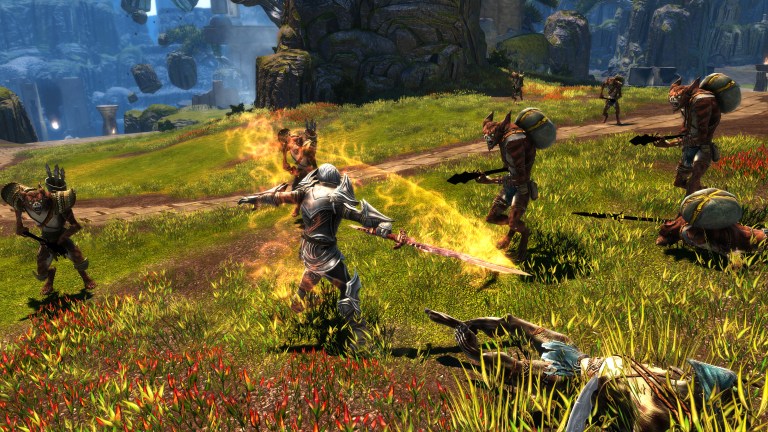Kingdoms of Amalur: Re-Reckoning Review – Barely Remastered
Kingdoms of Amalur: Re-Reckoning brings back the cult-classic RPG for modern consoles, but was it worth it?

In Kingdoms of Amalur: Reckoning, you play as the “Fateless One,” a hero unique in the world for his ability to change the fates of others however he or she sees fit. So it’s ironic that, given the opportunity to do whatever they wanted with this last-gen cult classic from 2012, developer Kaiko and publisher THQ Nordic did so little to improve the experience for the remaster.
Honestly, it’s a struggle to even note much of an update to the graphics. Character models are a little bit smoother. Parts of the varied fantasy world look a little bit brighter, but overall it doesn’t appear that textures have seen much of an improvement. There aren’t even many graphics options in the PC version. No one watching this game in motion is going to mistake it for a new release.
What has been updated in this remaster? Well, one welcome change is the removal of level locking. You’re now free to explore the world with enemies scaling to your level, so you’ll no longer wander into the wrong part of the map only to be promptly killed in one or two hits because you’re under leveled. Kaiko has also added a Very Hard difficulty for those looking for an extra challenge. And the two excellent add-ons, The Legend of Dead Kel and Teeth of Naros, are also included in the box. But that’s it for improvements.
In terms of new features, Re-Reckoning is one of the more disappointing re-releases in recent memory. The PC version isn’t very well optimized, either. The frame rate would regularly dip in the game’s many large, outdoor areas, and I ran into crashes every few hours. At least you can save anywhere.
Curiously, the one addition that could have made this remaster more worthwhile, a new five-hour add-on called Fatesworn, won’t be released until next year. And even then, it only comes with Re-Reckoning’s deluxe edition for an extra $15.
These days, most people are probably more familiar with the controversy surrounding Amalur’s development than the game itself. MLB pitcher Curt Schilling founded the game’s original developer, 38 Studios, in 2006 to create the next big RPG, at one point describing the project as a cross between God of War and The Elder Scrolls IV: Oblivion.
Schilling’s name attracted big talents like fantasy author R.A. Salvatore and Spawn creator Todd McFarlane, both of whom contributed to Kingdoms of Amalur. It also helped him secure millions of dollars in loans from the state of Rhode Island–loans that would never be repaid. Just a few months after the release of Amalur, 38 Studios filed for bankruptcy, igniting a legal battle that took years to resolve.
But despite its rocky history and the questionable improvements, there is still an enjoyable action RPG here, even if eight years on, Kingdoms of Amalur is definitely showing its age.
Combat is still Amalur’s strong suit. It has a sufficient heaviness to it that a lot of RPGs lack, though it never quite feels as good as God of War as Schilling might have hoped. That said, there are plenty of ways to customize your character to suit your combat style and needs. There are three basic classes: Might, Finesse, and Sorcery, but you’re free to mix and match classes and skill trees as you please. With a little planning, it’s completely viable to have a character that wields a giant warhammer with one button and magic staff with another.
Regardless of what you end up equipping, each fight is about increasing your Fate meter and ultimately unleashing a powerful, gory Reckoning attack, which can eliminate an entire group of enemies and give you a huge boots in experience points if you pull it off just right. But the camera, which was heavily criticized in the original release, is still troublesome during combat, often picking odd angles behind scenery, zooming out randomly, and regularly getting stuck underground.
Quests are another issue. Sure, there are lots of them, but they rarely involve more than killing a group of monsters, collecting a few specific trinkets, or going from point A to point B. Even the main quest doesn’t offer much variety outside of its boss fights.
Amalur’s story about the nature of fate is serviceable and the voice acting does hold up pretty well, but it’s largely an excuse to set up more combat encounters. And while the levels are large and varied, they’re ultimately just big zones with branching paths and don’t make up a truly open world. It’s a little difficult going back to a game like this after playing The Witcher 3 and Assassin’s Creed Odyssey.
Perhaps the most frustrating thing about Re-Reckoning is the lack updates to the UI, which feels especially cumbersome in 2020. For example, after pausing the game, you have to go into a separate screen to access your inventory. Weapons, armor, and consumables are then all located in their own menus within the inventory. So you’re on your third menu just to see if you want to equip the new sword you just picked up because there’s no other indication that it’s better or worse than what you’re already carrying. And if you’re looking to sell any items you don’t need anymore, make sure to mark them as junk while you’re there, because the game doesn’t offer much help in telling you what you don’t need anymore when you go to a vendor. I love how much loot is in Kingdoms of Amalur, but managing it is a pain.
In theory, a game like Kingdoms of Amalur: Reckoning is an ideal candidate for a remaster. When it was released in 2012, it felt like it was just a few tweaks away from greatness. Re-Reckoning could have made the improvements to elevate this cult classic, but barely tweaked graphics and level scaling alone make it hard to recommend a return trip to the Faelands.
